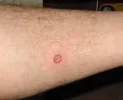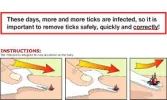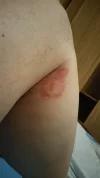I have had ticks"thankfully before they have started to bite to begin feeding in my groin area before now"...
I know in areas of the States there have been big outbreaks..
Tick cards have been around for a few years now and available in decent outdoor shops in the UK..I carry one in my wallet.
just found this. recently updated March 2015
Signs and symptoms of Lyme disease
Early symptoms
Many people with early-stage Lyme disease develop a distinctive circular rash at the site of the tick bite, usually around 3 to 30 days after being bitten. This is known as erythema migrans.
The rash is often described as looking like a bull's-eye on a dart board. The affected area of skin will be red and the edges may feel slightly raised.
The size of the rash can vary significantly and it may expand over several days or weeks. Typically it's around 15cm (6 inches) across, but it can be much larger or smaller than this. Some people may develop several rashes in different parts of their body.
However, around one person in every three with Lyme disease won't develop this rash.
Some people with Lyme disease also experience
flu-like symptoms in the early stages, such as tiredness (fatigue), muscle pain, joint pain,
headaches, a high temperature (fever), chills and
neck stiffness.
Later symptoms
More serious symptoms may develop several weeks, months or even years later if Lyme disease is left untreated or is not treated early on. These can include:
- pain and swelling in the joints (inflammatory arthritis)
- problems affecting the nervous system – such as numbness and pain in your limbs, paralysis of your facial muscles, memory problems and difficulty concentrating
- heart problems – such as inflammation of the heart muscle (myocarditis) or sac surrounding the heart (pericarditis), heart block and heart failure
- inflammation of the membranes surrounding the brain and spinal cord (meningitis) – which can cause a severe headache, a stiff neck and increased sensitivity to light
Some of these problems will get better slowly with treatment, although they can persist if treatment is started late.
A few people with Lyme disease go on to develop long-term symptoms similar to those of
fibromyalgia or
chronic fatigue syndrome. This is known as post-infectious Lyme disease. It's not clear exactly why this happens, but it's likely to be related to overactivity of your immune system rather than persistent infection.
When to see your GP
You should see your GP if you develop any of the symptoms described above after being bitten by a tick, or if you think you may have been bitten. Make sure you let your GP know if you've spent time in woodland or heath areas where ticks are known to live.
Diagnosing Lyme disease is often difficult as many of the symptoms are similar to other conditions. A spreading rash some days after a known tick bite should be treated with appropriate antibiotics without waiting for the results of a blood test.
Blood tests can be carried out to confirm the diagnosis after a few weeks, but these can be negative in the early stages of the infection. You may need to be re-tested if Lyme disease is still suspected after a negative test result.
If you have post-infectious Lyme disease or long-lasting symptoms, you may see a specialist in microbiology or infectious diseases. They can arrange for blood samples to be sent to the national reference laboratory run by Public Health England (PHE), where further tests for other tick-borne infections can be carried out.
How you get Lyme disease
If a tick bites an animal carrying the bacteria that cause Lyme disease (Borrelia burgdorferi), the tick can also become infected. The tick can then transfer the bacteria to a human by biting them.
Ticks can be found in any areas with deep or overgrown vegetation where they have access to animals to feed on. They're common in woodland and heath areas, but can also be found in gardens or parks.
Ticks don't jump or fly, but climb on to your clothes or skin if you brush against something they're on. They then bite into the skin and start to feed on your blood.
Generally, you're more likely to become infected if the tick remains attached to your skin for more than 24 hours. But ticks are very small and their bites are not painful, so you may not realise you have one attached to your skin.
Who's at risk and where are ticks found?
People who spend time in woodland or heath areas in the UK and parts of Europe or North America are most at risk of developing Lyme disease.
Most tick bites happen in late spring, early summer and autumn because these are the times of year when most people take part in outdoor activities, such as hiking and camping.
Cases of Lyme disease have been reported throughout the UK, but areas known to have a particularly high population of ticks include:
- Exmoor
- the New Forest and other rural areas of Hampshire
- the South Downs
- parts of Wiltshire and Berkshire
- parts of Surrey and West Sussex
- Thetford Forest in Norfolk
- the Lake District
- the North York Moors
- the Scottish Highlands
It's thought only a small proportion of ticks carry the bacteria that cause Lyme disease, so being bitten doesn't mean you'll definitely be infected. However, it's important to be aware of the risk and seek medical advice if you start to feel unwell.
Treating Lyme disease
If you develop symptoms of Lyme disease, you will normally be given a course of
antibiotic tablets, capsules or liquid. Most people will require a two- to four-week course, depending on the stage of the condition.
If you are prescribed antibiotics, it's important you finish the course even if you are feeling better, because this will help ensure all the bacteria are killed.
If your symptoms are particularly severe, you may be referred to a specialist to have antibiotic injections (intravenous antibiotics).
Some of the antibiotics used to treat Lyme disease can make your skin more sensitive to sunlight. In these cases, you should avoid prolonged exposure to the sun and not use sunbeds until after you have finished the treatment.
There's currently no clear consensus on the best treatment for post-infectious Lyme disease because the underlying cause is not yet clear. Be wary of internet sites offering alternative diagnostic tests and treatments that may not be supported by scientific evidence.
Preventing Lyme disease
There is currently no vaccine available to prevent Lyme disease. The best way to prevent the condition is to be aware of the risks when you visit areas where ticks are found and to take sensible precautions.
You can reduce the risk of infection by:
- keeping to footpaths and avoiding long grass when out walking
- wearing appropriate clothing in tick-infested areas (a long-sleeved shirt and trousers tucked into your socks)
- wearing light-coloured fabrics that may help you spot a tick on your clothes
- using insect repellent on exposed skin
- inspecting your skin for ticks, particularly at the end of the day, including your head, neck and skin folds (armpits, groin, and waistband) – remove any ticks you find promptly
- checking your children's head and neck areas, including their scalp
- making sure ticks are not brought home on your clothes
- checking that pets do not bring ticks into your home in their fur
How to remove a tick
If you find a tick on your or your child's skin, remove it by gently gripping it as close to the skin as possible, preferably using fine-toothed tweezers. Pull steadily away from the skin without twisting or crushing the tick.
Wash your skin with water and soap afterwards, and apply an antiseptic cream to the skin around the bite.
Don't use a lit cigarette end, a match head or substances such as alcohol or petroleum jelly to force the tick out.
Some veterinary surgeries and pet shops sell inexpensive tick removal devices, which may be useful if you frequently spend time in areas where there are ticks.




























